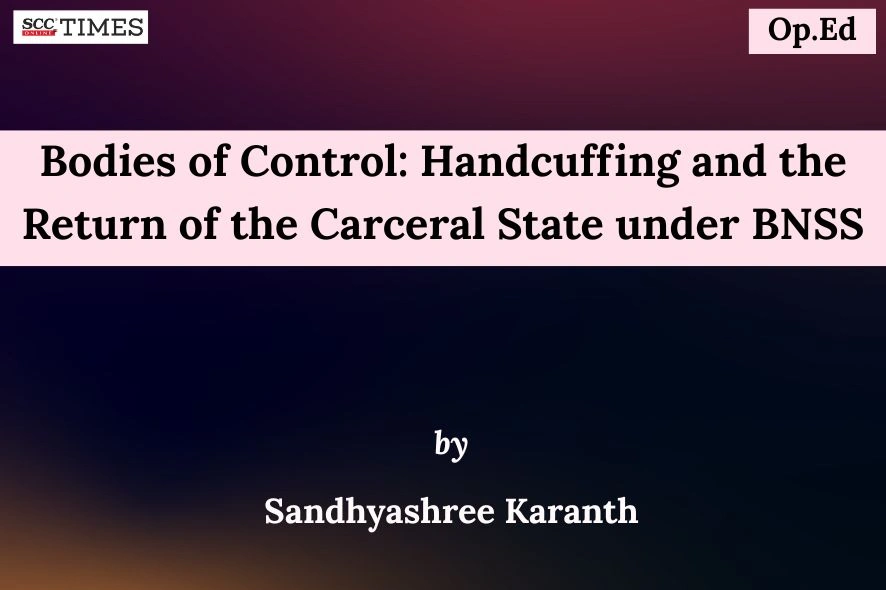“Handcuffing is prima facie inhuman and, therefore, unreasonable; it should be the last resort, not the first reflex.”
— Justice V.R. Krishna Iyer, Prem Shankar Shukla v. Delhi Admn.1
The Nagarik Suraksha Sanhita, 2023 (BNSS) was introduced as a break from colonial criminal procedure. Yet, Section 43(3) BNSS, which authorises the use of handcuffs for certain categories of accused persons, undermines this very purpose by reinstating a practice the Supreme Court has repeatedly condemned.2 It reintroduces physical restraint into the heart of criminal procedure, creating a dissonance between the rhetoric of reform and the reality of regression.
This article examines how Section 43(3) departs from established constitutional jurisprudence under Articles 14 and 21, institutionalising overcriminalisation through procedural means. It argues that the provision fails the test of proportionality, undermines the presumption of innocence, and revives colonial modes of bodily control inconsistent with the transformative vision of the Constitution.
The 2025 judgment illustrates the constitutional fault line.3 The Supreme Court held that the handcuffing of an accused without recorded justification and judicial oversight violates Articles 21 and 22(1). The Court reaffirmed that handcuffing is permissible only under demonstrable necessity and cannot be normalised by statutory discretion. Importantly, it clarified that Section 43(3) BNSS cannot dilute constitutional protections, any use of handcuffs must satisfy tests of fairness, necessity, and reasonableness.
Overcriminalisation through procedure
The doctrine of overcriminalisation cautions against the expansion of penal logic into spaces where regulation, not punishment, should suffice. Section 43(3) exemplifies this trend by making physical restraint a procedural default. Though handcuffing is not punishment in the technical sense, it performs a punitive function before guilt is established.
Jeremy Bentham reasoned that punishment, being “in itself evil,” is justified only when the harm it prevents outweighs the harm it inflicts.4 Handcuffing under Section 43(3) fails this utilitarian test. There is no empirical evidence that it prevents escape or violence in most arrests. The provision thus fails the Benthamite criteria of utility: It is inefficacious (it prevents no mischief), unprofitable (it inflicts humiliation and stigma), and needless (other legal mechanisms for ensuring custody already exist).
This overreach operates on three levels — substantive, procedural, and symbolic. Substantively, it criminalises pre-conviction restraint without judicial justification. Procedurally, it converts accusation into a ground for bodily control. Symbolically, it transforms the handcuffed body into a public display of State authority.
Constitutional tests and Article 21
In K.S. Puttaswamy v. Union of India5, the Supreme Court established that any restriction on liberty must satisfy legality, necessity, and proportionality. Section 43(3) satisfies only the first. While the objective of public safety is legitimate, the connection between handcuffing and security is empirically weak. Less intrusive alternatives, escorts, supervision, conditional bail, already exist. The harm caused by routine restraint, particularly its public spectacle, far outweighs speculative benefits.
Furthermore, “procedure established by law” must be fair, just, and reasonable. Section 43(3), by authorising restraint without individualised justification, creates a procedure that is neither fair nor reasonable. It converts precaution into punishment, reversing the presumption of innocence.
Article 14 and arbitrary classification
Section 43(3) classifies accused persons based on the “nature and gravity of offence” or their being “habitual or repeat offenders.” Article 14 requires that classifications be based on intelligible differentia and have a rational nexus to their objective.6 This provision satisfies neither. It presumes that certain offences necessarily correlate with risk of violence or escape, a proposition unsupported by evidence.
The classification is both overinclusive and underinclusive. It captures harmless accused charged under “serious” offences, while excluding genuinely dangerous persons accused of lesser crimes. Furthermore, Section 46 BNSS already permits the use of reasonable force during arrest, making Section 43(3) redundant. The duplication of authority results in arbitrary and excessive control, violating equality before law.
The visible body and the presumption of guilt
Michel Foucault describes the historical shift from public spectacles of punishment to more invisible systems of control.7 The BNSS reverses this trajectory. The visible act of handcuffing, broadcast through media and public display, renders the body of the accused the first site of punishment. The accused becomes guilty in appearance, if not in law.
Earlier jurisprudence emphasised that arrest and detention must respect human dignity.8 The accused “does not lose his fundamental rights upon arrest.” Section 43(3), however, normalises the very humiliation those cases sought to prevent. It allows the State to perform authority rather than administer justice.
Colonial continuities and the jurisprudence of control
The BNSS’s claim to decolonise criminal procedure stands contradicted by its substance. Section 43(3) revives the logic of the Police Act, 1861, a framework designed to surveil and discipline colonial subjects. The colonial State distrusted the Indian subject; the postcolonial State now distrusts its own citizen. India’s constitutional project was not to indigenise colonial institutions but to humanise them. By statutory approval of restraint without judicial review, the BNSS reverses this progress. It replaces a jurisprudence of freedom with one of control, where liberty exists at the State’s discretion. Transformative constitutionalism demands that law dismantle hierarchies of power and affirm dignity. Section 43(3) instead reinstates the colonial morality of submission, contradicting the very ethos it claims to reform.
Constitutional humanism and the need for reform
Defenders of Section 43(3) cite pragmatic concerns, police efficiency, risk prevention, and public safety. Yet constitutionalism begins where pragmatism ends. The issue is not whether restraint is ever necessary, but who determines its necessity and under what limits.
A constitutionally compliant framework would require recorded, case-specific justification; judicial authorisation or immediate post-facto review; and recognition that public display of restrained individuals violates dignity. Such safeguards would not impede enforcement but would restore legitimacy through accountability.
Conclusion
Section 43(3) BNSS embodies the tension between two visions of the Indian State, the carceral and the constitutional. It transforms liberty from a guaranteed right into a conditional privilege. The 2025 Vihaan Kumar judgment9 partially restores balance by reaffirming that statutory authorisation cannot override constitutional morality.
Handcuffing, though procedural in form, is philosophical in consequence. It collapses the boundary between suspicion and guilt, turning the process itself into punishment. A truly postcolonial criminal justice system must move from control to compassion, ensuring that the restraint of the citizen is always matched by the restraint of the State.
Until then, the BNSS remains a reform in form but not in spirit, a new law still bound by an old chain.
*3rd year BA LLB (Hons.) student, RV University. Author can be reached at: sandhyashreek.ballb23@rvu.edu.in.
1. Prem Shankar Shukla v. Delhi Admn., (1980) 3 SCC 526 : 1980 SCC (Cri) 815 : 1980 SCC OnLine SC 164.
2. Nagarik Suraksha Sanhita, 2023, S.43(3).
3. Vihaan Kumar v. State of Haryana, (2025) 5 SCC 799.
4. Jeremy Bentham, An Introduction to the Principles of Morals and Legislation (Oxford University Press, 1907) (First published 1789).
6. Shri Ram Krishna Dalmia v. S.R. Tendolkar, 1958 SCC OnLine SC 6.
7. Alan Sheridan (Tr.), Michel Foucault, Discipline and Punish: The Birth of the Prison (2nd Edn., Vintage Books, 1995).
8. Joginder Kumar v. State of U.P., (1994) 4 SCC 260 : 1994 SCC (Cri) 1172; D.K. Basu v. State of W.B., (1997) 1 SCC 416 : 1997 SCC (Cri) 92.



